UAF takes delivery of Research Vessel Sikuliaq
June 6, 2014

Sharice Walker
907-474-7208
6/6/2014
A ship was delivered today.
Not a physical, dropped-on-your-doorstep kind of delivery. This delivery was more like a birth, as tons of steel, aluminum and wiring began a new life as an ocean research vessel.
The Research Vessel Sikuliaq now officially exists after years of being just an idea, a proposal and a construction contract. The R/V Sikuliaq, pronounced “see-KOO-lee-ack,” is owned by the National Science Foundation and operated by the University of Alaska Fairbanks.
“The delivery of R/V Sikuliaq to the University of Alaska Fairbanks represents a major milestone in our efforts to modernize the U.S. academic research fleet and will provide the science community with technologically advanced tools to conduct cutting-edge research in polar waters,” said Bob Houtman, head of the NSF Ocean Sciences Integrative Programs Section.
Documents signed today mark the hand-off of Sikuliaq from the shipbuilder to UAF.
“Today marks a new era of oceanographic research, especially in our arctic waters,” said UAF Chancellor Brian Rogers. “UAF is looking forward to partnering with researchers from Alaska and around the globe to make tomorrow’s groundbreaking scientific discoveries.”

A thorough testing of all the ship’s systems in ocean and ice conditions will take place during the coming year as a follow up to the ship construction, but today’s delivery is a significant milestone as it signals a shift in focus from construction to operations.
“The significance of today’s acceptance of the Sikuliaq, after 30 years of effort, is almost impossible to fathom,” said Michael Castellini, dean of the UAF School of Fisheries and Ocean Sciences. “To be here at the very beginning of a great change in Arctic exploration, built on the shoulders of decades of visionaries and dedicated individuals, with a limitless future ahead, is a great day.”
During the next month, UAF will outfit the 261-foot ship and train the crew. Over the summer, the vessel will transit from the Great Lakes to the Pacific Ocean via the Panama Canal. In preparation for science operations, additional equipment will be installed and a series of testing exercises will be completed while Sikuliaq is en route.
The first research cruises are scheduled to begin in October in the Pacific Ocean. Sikuliaq is expected to arrive in Alaska waters in February. A commissioning ceremony in the ship’s homeport of Seward, Alaska, is scheduled for March 2015.

Sikuliaq is the first vessel in the U.S. academic research fleet capable of breaking through sea ice up to 2.5 feet thick, making it uniquely capable of conducting polar and sub-polar research. The ship will allow researchers to collect sediment samples directly from the seafloor, host remotely operated vehicles and use a suite of winches to raise and lower science equipment throughout the water column. The vessel is equipped with an array of sonar systems for mapping not only the ocean floor but also biomasses and ocean currents within the water column.
NSF announced funding for the vessel five years ago as the first major project funded from NSF’s portion of the American Recovery and Reinvestment Act. The total cost for the project is $200 million. The ship was designed by The Glosten Associates, marine architects located in Seattle, and built by Marinette Marine Corp. of Marinette, Wisconsin.
ON THE WEB www.sikuliaq.alaska.edu
SPECIAL EVENT: UAF will offer a virtual tour of the University of Alaska Museum of the North special exhibit, "Arctic Odyssey: Voyages of the R/V Sikuliaq," via Livestream June 20 at 9:30 a.m. Alaska Time (1:30 p.m. Eastern). Visit http://bit.ly/sikuliaqtour6-2014 to participate.
NOTE TO EDITORS: High-resolution photos of R/V Sikuliaq are available for download at http://bit.ly/sikuliaqdelivery.
SW/6-6-14/342-14


